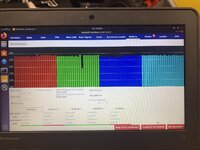Matt
E-Rider
- Likes
- 609
- Location
- Rochester, New York
I also have multiool and am located in central/western NY (rochester)
Yep for good measure. Pandora's Box, Schrodinger's Cat ensued.And I remember a time when us early Alta owners were begging the factory to provide this tool! They never did . . . . . . .
SRod's Cat, that's deep stuff. lol.Yep for good measure. Pandora's Box, Schrodinger's Cat ensued.
MultiTool can show you which cells in the battery are causing the imbalance (which triggers the code 36). However, the tool won’t let you reset the code. There are other codes you can reset, but code 36 isn’t one of them. And, yes, you can continue to ride on a code 36 battery, you will just have slightly less range.Anyone in the UK with a tool to reset. My EXR has done 729miles. Can I not ride with code 36 indefinitely. After all electric bikes done need maint right

It’s usually a broken wire bond to a single cell. So, for instance, if one of the 6 cells in one p-group has a broken wire bond, then the other 5 are providing the power expected of 6 cells. Assuming you can balance that p-group to the same level as the other p-groups in the module, then those cells are a bit overcharged. But as soon as you start using them, the 5 cell group will both discharge faster and charge faster than the other P-groups. Then the battery is unbalanced again.Thanks for the reply, So, is there no way to sort this unless you strip the pack and replace the bad cells? What about completely running the pack to “0” and then charge again? Won’t that balance them? Why does an imbalance just show up?
It’s usually a broken wire bond to a single cell. So, for instance, if one of the 6 cells in one p-group has a broken wire bond, then the other 5 are providing the power expected of 6 cells. Assuming you can balance that p-group to the same level as the other p-groups in the module, then those cells are a bit overcharged. But as soon as you start using them, the 5 cell group will both discharge faster and charge faster than the other P-groups. Then the battery is unbalanced again.
The fix is to either repair the wire bond, or just replace the whole module. There are 4 modules in the Alta pack, stacked like a layer cake. Replacing the module can have some other side effects. If it is replaced with a new module with new cells, and the other 3 modules have old cells, then the new module will charge faster and discharge slower than the old modules. That can also lead to a code 36, but a little more benign form. Each module is balanced with itself, but one module is just a bit fresher, and thus reaches its full charge limit before the other three. Not a huge problem, but again, it will lead to slightly reduced total range, since the other 3 modules will never quite have time to reach their full charge before the new module reaches the upper voltage limit.
@Rashid510 has quite a bit of experience repairing batteries, but I doubt the cost to ship from the UK to California would be worth it.
Ok I understand, like in the Tesla model S and X modules when you get burnt wire on the base of the pack and the pack reads slightly less Voltage. Is this easy to locate and repair? I’ll get in touch with @Rashid510 for help. ThanksIt’s usually a broken wire bond to a single cell. So, for instance, if one of the 6 cells in one p-group has a broken wire bond, then the other 5 are providing the power expected of 6 cells. Assuming you can balance that p-group to the same level as the other p-groups in the module, then those cells are a bit overcharged. But as soon as you start using them, the 5 cell group will both discharge faster and charge faster than the other P-groups. Then the battery is unbalanced again.
The fix is to either repair the wire bond, or just replace the whole module. There are 4 modules in the Alta pack, stacked like a layer cake. Replacing the module can have some other side effects. If it is replaced with a new module with new cells, and the other 3 modules have old cells, then the new module will charge faster and discharge slower than the old modules. That can also lead to a code 36, but a little more benign form. Each module is balanced with itself, but one module is just a bit fresher, and thus reaches its full charge limit before the other three. Not a huge problem, but again, it will lead to slightly reduced total range, since the other 3 modules will never quite have time to reach their full charge before the new module reaches the upper voltage limit.
@Rashid510 has quite a bit of experience repairing batteries, but I doubt the cost to ship from the UK to California would be worth it.
MultiTool can show you which cells in the battery are causing the imbalance (which triggers the code 36). However, the tool won’t let you reset the code. There are other codes you can reset, but code 36 isn’t one of them. And, yes, you can continue to ride on a code 36 battery, you will just have slightly less range.
